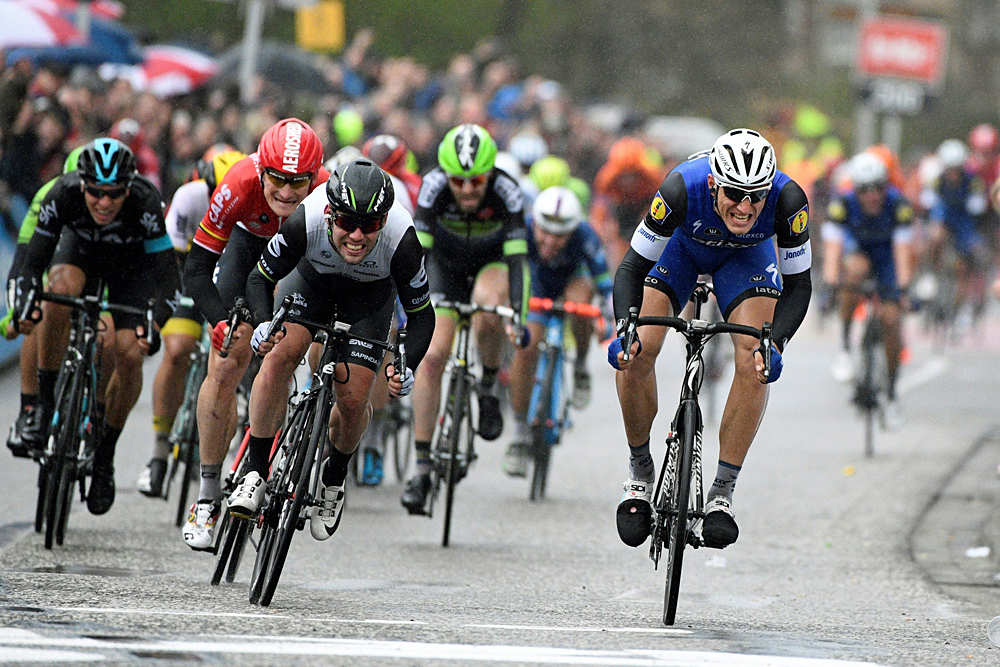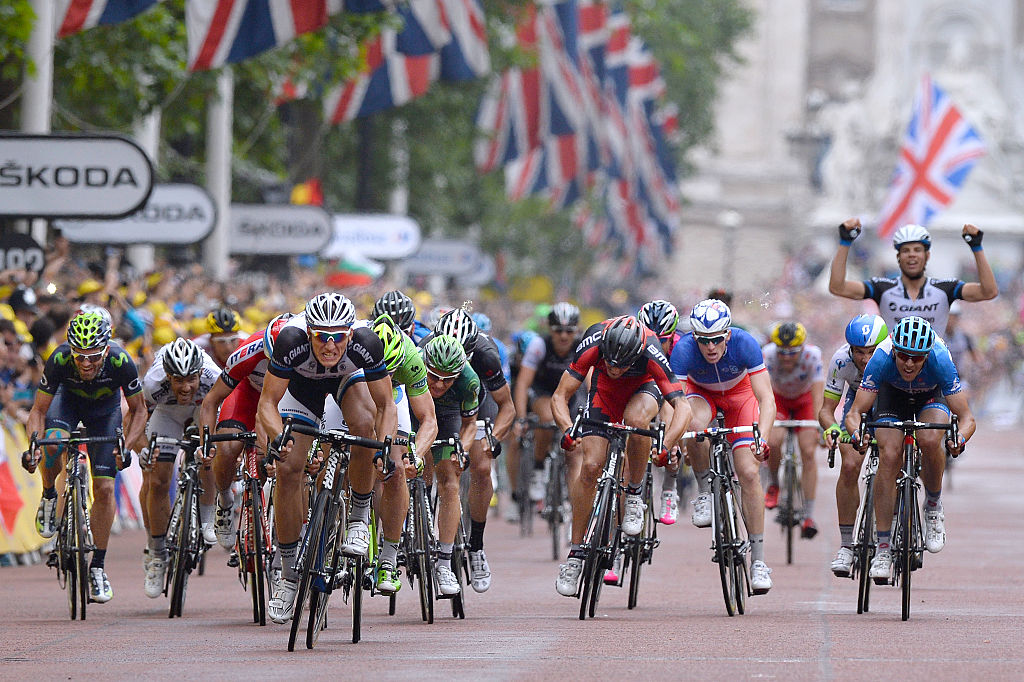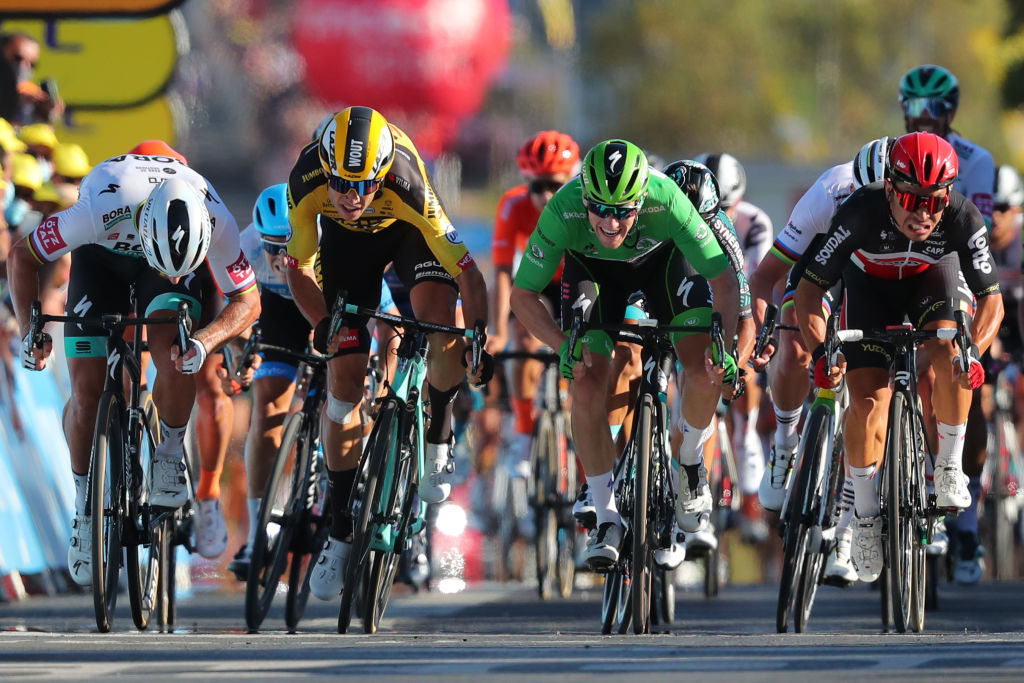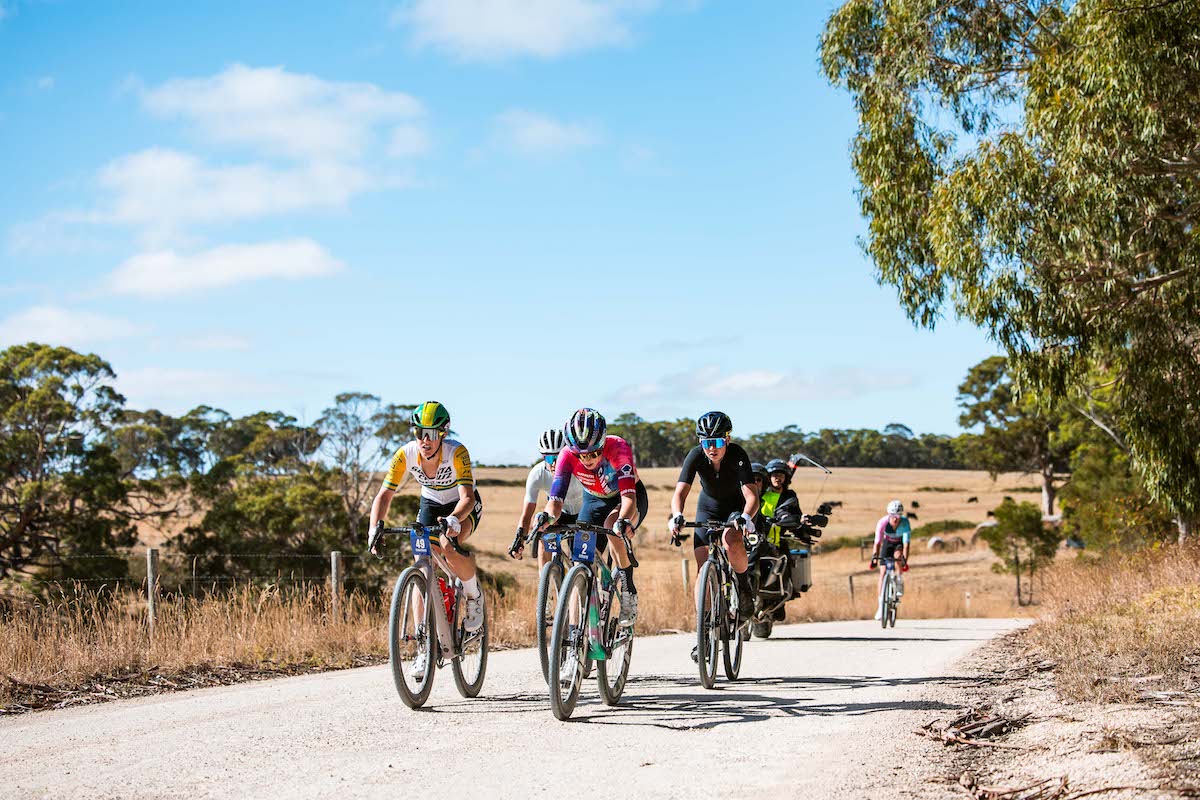The evolution of sprinting featuring Mark Cavendish, Marcel Kittel and Sam Bennett
Procycling talks to top athletes on how sprinting has changed

In January 2019, Mark Cavendish guest-edited an issue of Procycling magazine. Inside that issue was a feature in which some of the world's fastest riders discuss how sprinting has evolved, from lead-outs to training, and talk through how a sprint race unfolds. Featuring input from Cavendish, Marcel Kittel, Elia Viviani, André Greipel, and Sam Bennett.
This article was taken from Procycling magazine issue 251, January 2019.
"Sprinting has changed a lot in the last few years. You’re not just dealing with sprinters now, you’re dealing with a lot of lead-out trains. They’re hard to predict and the variables have increased." Mark Cavendish.
The win: 0 metres
Elia Viviani: If nobody is around you, or the speed is so high nobody can pass you in the last 10 metres, that is the best moment. It’s like a fraction of a second, but you enjoy that. And then you get the adrenaline. You have a really high level of adrenaline for the whole sprint, but when you make it to the line, all of the emotions explode.
The sprint: 200 metres
Mark Cavendish: People think sprinting is going from 150 metres or whatever. But 150m is short. It’s more like 200m or 250m and that’s when you have already been in the red for five minutes previous. Anybody can put out high wattage. It’s about how hard you can sprint when you’re in the red.
André Greipel: There’s always a bit of power you can get out of the legs. Sometimes, before you start your sprint you’re dead – really dead – but you still have some peak power. Sometimes you surprise yourself about what you can squeeze out. It’s finish line fever.
The latest race content, interviews, features, reviews and expert buying guides, direct to your inbox!
Marcel Kittel: The finish line is my red line. If I’m in good condition and I pass the finish line and I won, I won’t remember how deep I went in the last 5km.
Sam Bennett: It’s hard to break into that bubble of the top sprinters because nobody wants you there to be sprinting for the win.
Lead-out: 250m-1km
Cavendish: Before, you’d just have one guy to pilot fish you. That’s where the lead-out train comes from. In 2007, 2008, I was winning nine out of every 10 sprints I did. I just thought, if I get a lead-out I can win 10 out of 10 sprints. We just did it and it guaranteed the wins.
Kittel: The days of the big lead-out ended in 2013-14. When I think about the Tour in those years my team always had a battle with Lotto Soudal, and more sprinters were coming with strong teams.
Bennett: If there are not so many of the top guys at the race, you’re going to have to do more of a lead-out, because otherwise you’ll just get swamped. So many people want trains. I almost think there are too many and you have to go it alone.
Viviani: The best position is always when your lead-out goes with 1km to go and you have two guys and you know they will bring you to 200m to go. If you are not with the lead-out boys, the main position is to be on the wheel of the sprinter who has a lead-out. You need to understand who is organised.
Greipel: It’s not like there’s a full lead-out any more. A road only has a certain amount of space. It comes down to the last two riders in the front of the sprinter doing the correct thing. Now, a lot of teams try to make a perfect lead-out so it’s like dragster racing. To win you must be flying but it’s difficult because a lot of other teams are putting a lot of emphasis and attention on a lead-out.

Chaos: 1km-3km
Bennett: Sprints feel more cut-throat. There are so many good sprinters now and there’s not really one guy that stands out. Everybody is beatable. I think that’s what make it more chaotic: everyone knows they can win.
Cavendish: [At Highroad] other teams would try to get in on us, like Liquigas and Lotto, but they couldn’t. Even in 2011, it was ones and twos coming around – Greipel, Tyler Farrar – but we’d pick it up and were still pretty dominant.
Greipel: Sprint speeds and the chaos are as high as they’ve ever been, I think. It’s bike racing. Everybody can decide how much risk they’re going to take.
Viviani: The main chaotic moment is from 2km to 1km. At that moment you understand if you are in a good position to win or not - that is the chaotic moment because everyone wants to be in the position to win.
Tom Steels: For guys like Viviani who come from the track, chaos is second nature. It’s kind of a natural approach to the sprint. You can be as strong as a horse, but if you don’t have the feeling to find position then you can’t be fast – and in this period, it depends a lot on experience.
Kittel: At the end of the day there will always be one team that’s dominant and will come out of the chaos and do a lead-out. This year it was Quick-Step. It’s down to experience and power and it can change from race to race.
Dive bombers: 1km-5km
Cavendish: Contrary to belief, I might put myself at risk sometimes but I won’t put another rider at risk intentionally. It’s one thing putting yourself at risk; it’s another putting other riders at risk, [but] that’s become a bit of a problem now.
Bennett: When you do enough sprints you start to see patterns, like who follows who. That’s why I don’t wear shades with a frame underneath, because I like to look underneath my arms. The last 5km…is when I have to be aware of what’s happening and be on the radio or screaming to the first guy to block the road. If you feel you’re on one side and you can feel a surge coming on the left and you have the front…we’d already be taking the whole peloton to the other side of the road. It’s not chopping them or aggressive, but we have control of the front and we can go where we like.
Viviani: Every [dive bomber] move inside the last 2-3km is because the speed of the group is not super high and someone tries to do that move. But if a proper lead-out is in front it’s not easy to do a move.
Kittel: I consider [dive-bombing] part of the game and I don’t think people do it intentionally. They’re maybe nervous, they want to come to the front and maybe they do a crazy move sometimes. But there’s respect between the sprinters.

The build up: 5km-80km
Cavendish: The Tour is f*cking chaos. You don’t want to have to go out of the top 30 in the last 50km.
Bennett: From what I’ve seen, the Tour de France finale starts 50km or 80km out. In smaller races you can start 10km, 5km out. At the Giro d’Italia it’s maybe 15km to 20km to go. When we say we want to be together at a certain point then we have to be together.
Greipel: In the Tour, in the last hour it’s almost impossible to move up. If you want to have the whole support of the team, you have to be in the top 30.
Steels: You always look at the start – the dangerous points, a chance where the breakaway could go. Then you look in real detail at the last 50km – if there is a risk of an echelon, if there is an opportunity of an echelon, you can see it both ways. Then you really go into the last 10km, and then really in detail at the last 5km. We try to limit [the information over the radio to the riders], but depending on the course or the car in front you do give some extra. You have to be able to give the info to riders who have a heartbeat of 170.
Know your rivals
Bennett: I just watch sprints. I don’t think it’s even homework; it’s enjoyment I suppose. Everyone has their own sprinting style and personality in the last metres and you have to keep on top of that, but without being too obsessed about it. You have to focus on yourself – but it’s just about knowing your opponents.
Viviani: When we go to a race, we analyse who is there: which other sprinters; what teams are organised like us; who can do the last part or can compete with us. It’s just to understand who our rivals are in that moment. We plan the first few sprints the best way for us. If some really dangerous contenders [emerge], like in the Giro with Bennett, we try to understand how he beat us. For example, we lost in Praia a Mare and we understood that if he’s in my wheel on the last 50m he jumped me, so we need to change something. When Kittel is in the race we know he probably is stronger than me. It’s difficult for me to jump him because he has 300 watts more.
Cavendish: You look at what riders are there from other teams. Where they usually position. And you know when they can go from, how far they can go or if they’re nervous of being intimidated.
Kittel: I really only concentrate on myself and my team and our plan – that’s always been the most important thing and it always will be in the future.

Committing to the cause
Steels: When we leave the bus, we have about an 80 per cent plan how we’ll approach the final. If we have a sprinter on board, we always control the race and that gives a psychological advantage to the guys. It’s good for this generation – they really want us to control the race – so it’s not extra pressure. They just say, okay let’s go for it.
Cavendish: [At Highroad] it was more than a job. It was a group of guys. We didn’t train together, we never trained the lead-out, but we committed to each other. Everyone felt part of the win. And you didn’t have anybody trying to get into the top 20 and saving themselves. This year in this team, 2019, our team is picked for personality as well as talent.
Greipel: The team always helped me with a perfect lead-out and that’s why I was quite successful. Afterwards, we analysed the race if something went wrong. As a lead-out train we tried to adapt together because we win and lose together.
Bennett: The more important thing is to keep the same guys in the races in front of you. My last guy learns what I need and I already know what he’s thinking – but he also needs that same relationship with the guy in front of him. These are split-second decisions and you have to know each other really well.
Viviani: When you start the season, you want to have the two last guys in the lead-out stay the same, because the feeling in that moment of the race really makes the difference. They need to know everything about the sprinter and the more races they do with you is always better.
Fine-tuning and practice
Sebastian Weber: Sprinters have become more specifically sprinters and so have sacrificed a little bit of endurance. For example, André’s power output increased 15 per cent over the past 10 years – that’s what you need to do to keep up. When he first went to Lotto we built two teams who raced each other at training camps. One was the actual lead-out and the other was there to smash their tactics, disrupt it. The benchmark was the lower the effort André made to that point, the better. It was extremely positive training.
Kittel: I think a rider in general needs to find out over the years what is good for him. I always did specific sprint training but no top-secret things. I just integrated sprints into my ride, went to the gym… in the end it’s all about being in top condition so you can show your strength and power. I’ve changed coaches and tried different training methods but the result is always the same. If I train good, sleep good and eat good I will be very fast.
Bennett: Sprinters have to have a much bigger engine nowadays. So many sprinters can climb as well, so not only do you have to be able to read the sprint and be quick and be smart you have to be really strong as well.
Viviani: I always put the track in my preparation, it’s short but it’s really high-quality work. I do a lot of standing starts. It’s easier to motor-pace without a super-big gear. You go at 100, 110rpm, then every five minutes do a good sprint, go from 100rpm to 130 in one lap really full, then back on the motor-pace. It’s like a proper motor-pace I do on the road, but... fixed gear is the main thing, because if you go [with] 100rpm you go 100rpm one hour, you can’t change from 50, 60, 80 then 100; you go there and you do it at this speed, at this rpm. When you go into the last kilometre on the road, I need to analyse everything in a moment: who is doing a lead-out in front of me; if I am in a good position; the corner coming up; where the wind is coming from; whether a sprinter is coming from behind who I could use as a lead-out. These things you need to analyse in two seconds and do the action. The track helped me mentally with that part, to be always ready to take the decision at the right moment.
Procycling magazine: the best writing and photography from inside the world's toughest sport. Pick up your copy now in all good newsagents and supermarkets, or get a Procycling subscription.
Sam started as a trainee reporter on daily newspapers in the UK before moving to South Africa where he contributed to national cycling magazine Ride for three years. After moving back to the UK he joined Procycling as a staff writer in November 2010.
